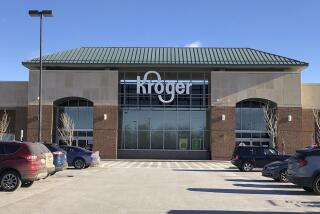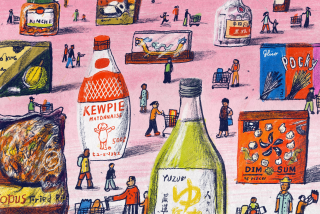Big Boxes Battle in China
- Share via
Urumqi, China — In this remote region along the old Silk Road, Carrefour is on the march.
The Paris-based retailer has already opened two stores here, one in the northern end where many ethnic Chinese live and another next to a mosque in the Muslim section populated by Uighurs. This fall, Carrefour will open a third mega-store in this city of 2 million, selling groceries alongside its other goods.
What about Wal-Mart Stores Inc.?
“I can’t imagine they will come here,” Christian Roquigny, who manages Carrefour’s Uighur store, said as he walked past a golden-domed mosque, nodding to men coming out after Friday afternoon prayers.
Roquigny boasted that his store sold no pork and was certified as halal, or permissible under Islamic dietary law. Wal-Mart managers, he said, aren’t given the same flexibility to adapt.
As the world’s leading retailers battle for new markets around the globe, they are increasingly setting up in places like Urumqi, where Carrefour’s average checkout total is just over $5.
Wal-Mart and Carrefour, the world’s No. 1 and No. 2 retailers, have stepped up their expansion in China in recent years, virtually matching each other, store for store, in many locales. But the nearest Wal-Mart to Urumqi is 1,400 miles to the east.
Carrefour’s operation in this western city demonstrates why the French company has raced ahead of those of its multinational rivals in the world’s most-populous nation. By joining with Chinese partners, adapting to local culture and employing a supply chain that includes 18-wheel trucks and three-wheel bicycles, Carrefour has become the biggest foreign retailer operating in China.
It operates 79 stores in 32 Chinese cities compared with 60 locations in 30 cities for Wal-Mart. Last year, Carrefour’s sales in China totaled $2.2 billion, compared with $1.2 billion for Wal-Mart, according to the Commerce Ministry in Beijing.
“Carrefour’s management is quite flexible and their localization is better,” said Huang Guoxiong, a business professor at Renmin University of China in Beijing. Localization is an industry term for adapting a store to local tastes and preferences.
Wal-Mart is accelerating its store openings in China -- it plans to open at least 18 this year, six more than Carrefour -- and analysts are reluctant to bet against the Bentonville, Ark.-based discount retailer given its enormous resources. Its global sales last year reached $285 billion, triple that of Carrefour’s. Wal-Mart bought $18 billion in goods from Chinese manufacturers last year.
But as a retailer in China, Wal-Mart is a small fish. Its strategy of offering tian tian ping jia, or “everyday low prices,” hasn’t had a big effect on Chinese mom-and-pop shops that are used to cutthroat pricing. Wal-Mart has been unable to replicate its super-efficient logistics system in China largely because it lacks scale.
Even Wal-Mart’s staunch anti-union stance is being challenged, ironically, in a country where unions have little power. Government-backed trade union officials in China have been trying to organize workers at foreign enterprises and have been especially critical of Wal-Mart’s resistance to the idea.
None of Wal-Mart’s stores in China is unionized, says Huang Jianling, the company’s public relations manager in China. She declined to say whether any of the retailer’s 30,000 workers in China had expressed interest in forming a union. By comparison, about three-quarters of Carrefour’s 34,000 employees in China are union members.
Wal-Mart beat Carrefour to China by a few months, sending executives to the Middle Kingdom in 1994. But it wasn’t until two years later that Wal-Mart opened its first super-center in Shenzhen, an industrial city that borders Hong Kong. After building a cluster of stores in China’s southeast, Wal-Mart started to push up the coast and sought to break into Shanghai.
But when it approached authorities, Beijing instead offered a license in Shenyang, in the gritty northeast region near North Korea, says Paul French, founder of Asia Access, a market research firm in Shanghai.
Shanghai officials didn’t go out of their way to help, either. Some grumbled that Wal-Mart waltzed into town and began pressing for favorable terms, playing one district government against another.
Carrefour, meanwhile, bypassed Beijing and cut deals directly with local governments. “They would go to the local mayor, the [Communist] party guy and say, ‘I’ll bring you a Carrefour store, pay taxes, create jobs, pay rent,’ ” French said.
Local officials were thrilled. Beijing later caught on and slowed Carrefour’s growth, but by then the retailer had already locked up some of the best sites in cities such as Shanghai.
Wal-Mart opened its first store in Shanghai last year. Carrefour has been in the eastern metropolis since 1996 and has 10 stores in the city, one of China’s wealthiest.
More recently Shanghai and some other cities have made it tougher for big-box retailers to open stores in dense areas, in part to protect smaller businesses. In addition, the retailers, including Carrefour, Wal-Mart, Britain’s Tesco and Germany’s Metro, face increased scrutiny from regulatory agencies.
One of Carrefour’s Shanghai stores was fined almost $7,000 for selling expired pork. Some other Carrefours got in trouble for marketing pirated World Cup soccer balls and fakes of another famous French brand, Louis Vuitton. Wal-Mart was forced to remove some children’s clothing after Chinese officials said the garments contained cancer-causing dye.
“They have to show the world they are doing something,” said Jean Luc Chereau, Carrefour’s president in China, referring to tougher government oversight. Still, Chereau said, it won’t inhibit the company’s expansion, insisting that Carrefour had built goodwill with the central government, most recently by heeding Beijing’s call to go west and invest in places like Urumqi.
Chereau wouldn’t specify what he’d been promised in return, but hinted at licenses to open in large coastal areas.
“I played the game,” he said.
Carrefour has more international experience than Wal-Mart. The French company operates in 29 countries, about double the number for Wal-Mart. Both chains have struggled in Asia, however, pulling out of countries such as South Korea. And despite their push in China, Chinese retailers dominate here.
At 57, Chereau has spent three decades with Carrefour, including eight years in Spain and six years in Taiwan before moving to Shanghai as chief of the retailer’s Chinese operation in 1999. Chereau doesn’t speak Mandarin but says he learned about Chinese shoppers and their styles while building Carrefour’s business in Taiwan. “We adapt to the local market,” he said.
That’s a mantra at Carrefour, but it doesn’t always save them from blunders. In Urumqi, managers still talk about the 20 varieties of French wine that filled the shelves at the store’s grand opening two years ago. Weeks passed and hardly a bottle was sold. At $12 or more a bottle, few people could afford it. All but one or two labels have since been removed and replaced with local wine from Xinjiang that sells for $1 a bottle.
“It’s still a problem getting rid of them,” said division manager Alice Zhao, looking up at a row of Bordeaux at the very top of the shelf.
Zhao, a 33-year-old Urumqi native, studied in Australia before returning home to take a job at Carrefour. She is one of 300 employees at the store, about half of them Uighurs, a Turkic people who have flourished for centuries in Xinjiang. Carrefour clerks start out at about $90 a month.
Roquigny, the store manager, laughs at the wine faux pas. For the Bordeaux native, stacking liquor shelves with French wine didn’t seem so odd. He said three more French nationals have moved to Urumqi recently, bringing the total to four. “That’s quadrupling sales,” he joked.
But as he walked through the store, which at about 72,000 square feet is like a small Wal-Mart in the states, he pointed to a vast assortment of local favorites: 20 varieties of raisins, roasted mutton in plastic bags, horse-meat sausage in the winter (to warm up the body, Uighurs say), snow lily tea from the nearby Tianshan mountains.
Carrefour invested about $5 million to open the Uighur store and records $1.3 million in sales most months. To make a profit, it needs to boost that figure to around $1.5 million .
Joe Hatfield, Wal-Mart’s chain-smoking chief of China operations who worked under Wal-Mart founder Sam Walton, has learned from some early missteps as well.
Wal-Mart struggled with its Sam’s Club warehouse-styled outlets in Beijing and Shenzhen because few Chinese have cars big enough to carry bulk products or homes with ample storage space. Market analyst French remembers shoppers gasping when Wal-Mart tried to sell gutted fish in plastic wrap, as grocers do in America.
“The Chinese make their decision on the 5 Fs,” he said. That’s F for fresh -- fresh fish, fruits, vegetables, meats and seafood.
That point wasn’t lost on Hatfield as he geared up for the opening of Wal-Mart’s Chongqing mega-store last year. After watching employees, in their blue vests with smiley faces, do the Wal-Mart cheer, the 61-year-old native of Baltimore, who speaks no Chinese, walked past tanks of hyperactive perch and eel, live bullfrogs from nearby rivers, turtles, roasted duck and rotisserie chicken in a box for less than 90 cents a bird.
“The box costs more than that in the U.S.,” Hatfield said.
About 120,000 customers passed through the doors of the Chongqing store on that first day.
Wal-Mart wants to hold a lot more grand openings like that in China, a market the company can ill afford to be an also-ran. Wal-Mart executives have said that China, with its population of 1.3 billion, is the one place where the retailer can hit another $100 billion in sales. Last year China accounted for just one-third of 1% of Wal-Mart’s total sales.
The more stores it can open, the better chance Wal-Mart can leverage its mass scale to squeeze prices lower and drive efficiencies in purchasing, inventory management and distribution.
But transportation experts say it will be a few years before Wal-Mart can transplant its famous logistics capability in the U.S. to China. At the moment, no national freight carrier such as Yellow Transportation exists in China. Instead, about 4 million businesses operate 5 million trucks. Delivery vehicles that make long trips must return to their base empty because of a lack of uniform regulation. Also, there’s no uniform system of tracking goods, issuing invoices or collecting payments by credit.
All of which plays more to Carrefour’s strengths.
“It’s highly fragmented, so we have to keep our flexibility,” said Christophe De Nays Candau, Carrefour’s supply chain manager in China.
He said he didn’t care what vehicle pulled into Carrefour’s receiving dock, as long as it got the job done. “We still use the bike if it’s the lowest cost and most efficient.”
More to Read
Inside the business of entertainment
The Wide Shot brings you news, analysis and insights on everything from streaming wars to production — and what it all means for the future.
You may occasionally receive promotional content from the Los Angeles Times.











